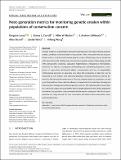Files in this item
Next-generation metrics for monitoring genetic erosion within populations of conservation concern
Item metadata
| dc.contributor.author | Leroy, G. | |
| dc.contributor.author | Carroll, E. L. | |
| dc.contributor.author | Bruford, M. W. | |
| dc.contributor.author | DeWoody, J. A. | |
| dc.contributor.author | Strand, A. | |
| dc.contributor.author | Waits, L. | |
| dc.contributor.author | Wang, J. | |
| dc.date.accessioned | 2017-11-23T16:30:09Z | |
| dc.date.available | 2017-11-23T16:30:09Z | |
| dc.date.issued | 2018-08 | |
| dc.identifier | 251451798 | |
| dc.identifier | ad49093f-3c44-4825-b605-74b7f685bd2f | |
| dc.identifier | 85034744287 | |
| dc.identifier | 000439505200004 | |
| dc.identifier.citation | Leroy , G , Carroll , E L , Bruford , M W , DeWoody , J A , Strand , A , Waits , L & Wang , J 2018 , ' Next-generation metrics for monitoring genetic erosion within populations of conservation concern ' , Evolutionary Applications , vol. 11 , no. 7 , pp. 1066-1083 . https://doi.org/10.1111/eva.12564 | en |
| dc.identifier.issn | 1752-4571 | |
| dc.identifier.other | RIS: urn:14E6CE8513649ED2048665E06477330C | |
| dc.identifier.other | RIS: urn:14E6CE8513649ED2048665E06477330C | |
| dc.identifier.uri | https://hdl.handle.net/10023/12161 | |
| dc.description | This work was conducted as a part of the Next-generation Genetic Monitoring Working Group at the National Institute for Mathematical and Biological Synthesis, sponsored by the National Science Foundation through NSF Award #DBI-1300426, with additional support from The University of Tennessee, Knoxville. Emma Carrol was supported by a Marie Slodowska Curie Fellowship, (Behaviour-Connect) funded by the EU Horizon2020 program. MWB was supported by a Royal Society Wolfson research merit award. LW was supported by the University of Idaho. This research was supported in part by NSF awards 1355106 and 1357386 to AES. | en |
| dc.description.abstract | Genetic erosion is a major threat to biodiversity because it can reduce fitness and ultimately contribute to the extinction of populations. Here, we explore the use of quantitative metrics to detect and monitor genetic erosion. Monitoring systems should not only characterize the mechanisms and drivers of genetic erosion (inbreeding, genetic drift, demographic instability, population fragmentation, introgressive hybridization, selection) but also its consequences (inbreeding and outbreeding depression, emergence of large effect detrimental alleles, maladaptation and loss of adaptability). Technological advances in genomics now allow the production of data the can be measured by new metrics with improved precision, increased efficiency and the potential to discriminate between neutral diversity (shaped mainly by population size and gene-flow) and functional/adaptive diversity (shaped mainly by selection), allowing the assessment of management-relevant genetic markers. The requirements of such studies in terms of sample size and marker density largely depend on the kind of population monitored, the questions to be answered and the metrics employed. We discuss prospects for the integration of this new information and metrics into conservation monitoring programmes. | |
| dc.format.extent | 18 | |
| dc.format.extent | 1521408 | |
| dc.language.iso | eng | |
| dc.relation.ispartof | Evolutionary Applications | en |
| dc.subject | Conservation | en |
| dc.subject | Monitoring | en |
| dc.subject | Genomics | en |
| dc.subject | Effective population size | en |
| dc.subject | Inbreeding | en |
| dc.subject | Adaptation | en |
| dc.subject | SNP | en |
| dc.subject | QH301 Biology | en |
| dc.subject | QL Zoology | en |
| dc.subject.lcc | QH301 | en |
| dc.subject.lcc | QL | en |
| dc.title | Next-generation metrics for monitoring genetic erosion within populations of conservation concern | en |
| dc.type | Journal item | en |
| dc.contributor.sponsor | European Commission | en |
| dc.contributor.institution | University of St Andrews. School of Biology | en |
| dc.contributor.institution | University of St Andrews. Sea Mammal Research Unit | en |
| dc.identifier.doi | https://doi.org/10.1111/eva.12564 | |
| dc.description.status | Peer reviewed | en |
| dc.identifier.grantnumber | 656774 | en |
This item appears in the following Collection(s)
Items in the St Andrews Research Repository are protected by copyright, with all rights reserved, unless otherwise indicated.

